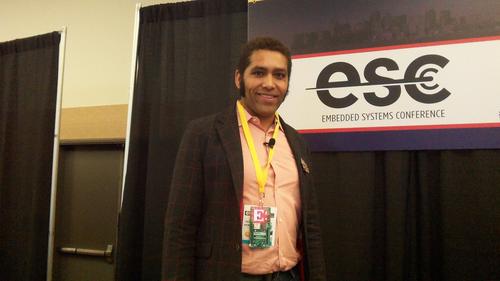What Engineers Can Learn from the Maker Movement
The so-called “maker movement” may not be big on degrees and formal training, but it can teach the engineering community valuable lessons in product design, an expert at UBM’s Embedded Systems Conference said this week.
April 14, 2016
"The maker movement helps translate technology into products,” said Kipp Bradford, a prolific inventor, design engineer, and research scientist at MIT’s Media Lab. “It helps do that in ways that are funky, creative, ridiculous, absurd, stupid, and sometimes profoundly beneficial.”
Kipp Bradford told engineers at UBM’s Embedded Systems Conference that the maker movement helps transform ideas into products “in ways that are funky, creative, ridiculous, absurd, stupid, and sometimes profoundly beneficial.”
(Source: Design News)
Bradford, who holds bachelor’s and master’s degrees in bioengineering from Brown University and has designed countless medical and consumer products, told an audience of 250 engineers that makers are here to stay. He cited two important qualities that the makers offer: They focus on specific human needs and they iterate quickly.
”Innovation is having the ability to see what the societal impact of your work will be, and then choosing the work that will give the best societal impact,” he told Design News in a separate discussion after his speech. Although many engineers have mastered those insights, the formal process of engineering education doesn’t necessarily help, he said
He cited two engineers who have mastered what he called the “human-in-the-loop” concept. Hugh Herr of MIT’s Media Lab, a double-amputee who lost his legs in a climbing accident, has spent his career making better prosthetics. And Dean Kamen, notable for the creation of the Segway, changed the lives of diabetics by designing a better insulin pump. “Dean Kamen is not a diabetic, but he was insightful enough to say, ‘This is a problem and I think I have a better way of doing it,’” Bradford said.
Both inventors are, in a sense, makers, Bradford said. They follow a vision and develop their ideas quickly, without the influence of large design teams. “This is an important idea for companies to understand,” he told the ESC audience. “It flips the paradigm on its head. Instead of going through lots of intensive research processes about what to build, what happens if people just build the thing they like and put it out in the world?”
By stripping away the corporate filters and mechanisms in the conventional design process, the market itself becomes the filter, he said.
Bradford acknowledged that all products can’t be built in that way. Satellites, cars, and pacemakers are examples of products that must adhere to strict design processes, but that’s not the case for all engineered products. Many could benefit from fast iterations that allow the market to make the final judgment.
”There’s a very real risk that you could put stupid products out in the market,” he said. “But you could do that anyhow. Plenty of companies do it today.”
Bradford urged engineers to be open to the fast, creative processes that are the hallmark of the maker movement. That hasn’t always been the case up to now, he added. “I remember when Arduino first came out, a lot of professionals said, ‘That’s just candy for a lot of pot-smoking art school students who want to pretend to do engineering.’”
But a lack of a formal grounding in the sciences doesn’t necessarily mean that their methods are wrong or their ideas lack value, he said. The lesson for engineers is that good ideas, iterated quickly, can blossom into profoundly important products.
”The future will not only be determined by science and technology,” he said. “That’s not to say that engineering isn’t going to be an important part of the future. But engineers have to learn to work with designers, artists, and society.”
Senior technical editor Chuck Murray has been writing about technology for 32 years. He joined Design News in 1987, and has covered electronics, automation, fluid power, and autos.
About the Author(s)
You May Also Like




